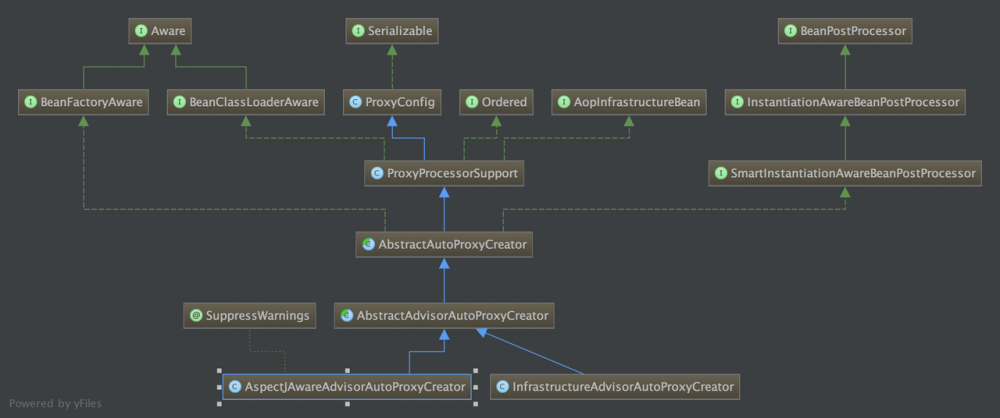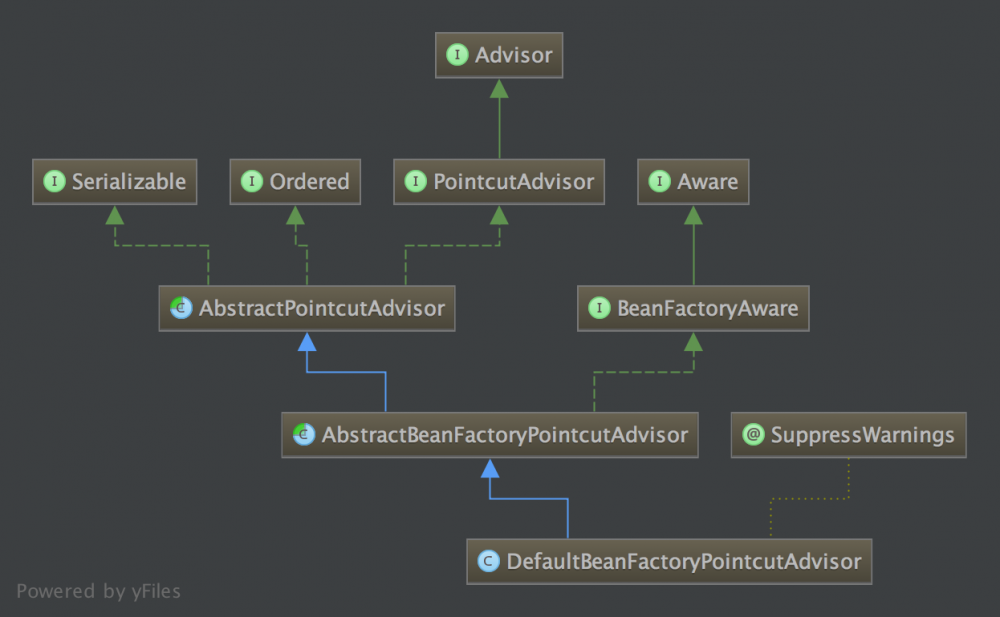Spring AOP源码实现分步解析
最基本的使用,在创建了业务接口和实现类后,通过配置 <aop:config>....</aop:config> 标签来指定 <aop:pointcut 和 <aop:advisor 。示例如下:
1.1.1 创建接口及实现类
接口:
public interface MockService {
public String hello(String s);
}
复制代码
实现类:
public class MockServiceImpl implements MockService {
@Override
public String hello(String s) {
System.out.println("execute hello");
return s;
}
}
复制代码
1.1.2 实现方法拦截
实现接口 org.aopalliance.intercept.MethodInterceptor
public class CustomInterceptor implements MethodInterceptor {
@Override
public Object invoke(MethodInvocation invocation) throws Throwable {
System.out.println("CustomInterceptor before");
Object result = invocation.proceed();
System.out.println("CustomInterceptor after");
return result;
}
}
复制代码
1.1.3 配置xml
创建 aop.xml ,放在resources目录下:
<?xml version="1.0" encoding="UTF-8"?>
<beans xmlns="http://www.springframework.org/schema/beans"
xmlns:aop="http://www.springframework.org/schema/aop"
xmlns:xsi="http://www.w3.org/2001/XMLSchema-instance"
xsi:schemaLocation="http://www.springframework.org/schema/beans
http://www.springframework.org/schema/beans/spring-beans-2.5.xsd
http://www.springframework.org/schema/aop
http://www.springframework.org/schema/aop/spring-aop-2.5.xsd"
default-lazy-init="false" default-autowire="byName">
<!-- 实现来org.aopalliance.intercept.MethodInterceptor的拦截器 -->
<bean id="customInterceptor" class="com.xxx.yyy.CustomInterceptor"/>
<bean id="mockService" class="com.xxx.yyy.MockServiceImpl"/>
<aop:config proxy-target-class="true">
<aop:pointcut id="interceptorPointCuts" expression="execution(* com.xxx.yyy..*.*(..))"/>
<aop:advisor advice-ref="customInterceptor" pointcut-ref="interceptorPointCuts"/>
</aop:config>
</beans>
复制代码
1.1.4 运行
public class Main {
public static void main(String[] args){
ApplicationContext context = new ClassPathXmlApplicationContext("aop.xml");
MockService mockService = (MockService) context.getBean("mockService");
mockService.hello("mock");
}
}
复制代码
返回:
CustomInterceptor before execute hello CustomInterceptor after 复制代码
1.2 AOP实现过程
Spring环境启动过程中,会调用 AbstractApplicationContext.refresh() ,AOP的实现流程,也就是从这里开始。
- 1 在
obtainFreshBeanFactory()执行过程中,加载 aop.xml ,并根据 namespace 找到aop对应的 NamespaceHandler :AopNamespaceHandler; - 2
AopNamespaceHandler中,找到 config 标签对应的 BeanDefinitionParser 的实现对象,也就是ConfigBeanDefinitionParser; - 3 执行
ConfigBeanDefinitionParser.parse,有两个作用:- 以
AspectJAwareAdvisorAutoProxyCreator注册BeanDefinition; - 解析
pointcut,advisor等标签,并将相关对象注册为BeanDefinition。
- 以
- 4 注册BeanPostProcessor:
AspectJAwareAdvisorAutoProxyCreator是BeanPostProcessor的实现类AbstractAutoProxyCreator的子类。注册BeanPostProcessor后,AspectJAwareAdvisorAutoProxyCreator会在Spring创建bean的代理过程中调用。 - 5 创建proxy,并用advisor增强,主要有几步:
- 创建代理;
- 查找匹配的advisor;
- 增强代理。
2 AopNamespaceHandler
Spring环境的加载,需要调用AbstractApplicationContext.refresh()。
在refresh()方法中,执行 ConfigurableListableBeanFactory beanFactory = obtainFreshBeanFactory(); 创建BeanFacotry的时候,加载并解析xml资源。
在这个过程中,会调用 BeanDefinitionParserDelegate.parseCustomElement 进行扩展标签的解析:
public BeanDefinition parseCustomElement(Element ele, BeanDefinition containingBd) {
// 获取namespace
String namespaceUri = getNamespaceURI(ele);
// 根据文件META-INF/spring.handlers,获取对应的NamespaceHandler
NamespaceHandler handler = this.readerContext.getNamespaceHandlerResolver().resolve(namespaceUri);
if (handler == null) {
error("Unable to locate Spring NamespaceHandler for XML schema namespace [" + namespaceUri + "]", ele);
return null;
}
// 调用NamespaceHandler.parse方法,返回BeanDefinition
return handler.parse(ele, new ParserContext(this.readerContext, this, containingBd));
}
复制代码
详细过程可参考 Spring自定义标签配置的源码解析与实现 。
对于 <aop:config/> ,Spring会根据 xmlns 去 META-INF/spring.handlers 文件中查找相应的namespace解析类: http/://www.springframework.org/schema/aop=org.springframework.aop.config.AopNamespaceHandler 。
在 AopNamespaceHandler 中: registerBeanDefinitionParser("config", new ConfigBeanDefinitionParser());
所以:
-
aopnamespace的解析类是AopNamespaceHandler -
<aop:config/>标签的解析类是ConfigBeanDefinitionParser,在ConfigBeanDefinitionParser中,<aop:config/>定义的各个元素被解析为BeanDefinition。
3 ConfigBeanDefinitionParser
ConfigBeanDefinitionParser 实现了 BeanDefinitionParser 接口,在 parse(Element element, ParserContext parserContext) 方法中,实现了两部分功能:
AspectJAwareAdvisorAutoProxyCreator
@Override
@Nullable
public BeanDefinition parse(Element element, ParserContext parserContext) {
CompositeComponentDefinition compositeDef =
new CompositeComponentDefinition(element.getTagName(), parserContext.extractSource(element));
parserContext.pushContainingComponent(compositeDef);
// 注册AspectJAwareAdvisorAutoProxyCreator为BeanDefinition
configureAutoProxyCreator(parserContext, element);
List<Element> childElts = DomUtils.getChildElements(element);
for (Element elt: childElts) {
String localName = parserContext.getDelegate().getLocalName(elt);
if (POINTCUT.equals(localName)) {
// 解析pointcut
parsePointcut(elt, parserContext);
}
else if (ADVISOR.equals(localName)) {
// 解析advisor
parseAdvisor(elt, parserContext);
}
else if (ASPECT.equals(localName)) {
parseAspect(elt, parserContext);
}
}
parserContext.popAndRegisterContainingComponent();
return null;
}
复制代码
其中:
private static final String POINTCUT = "pointcut"; private static final String ADVISOR = "advisor"; private static final String ASPECT = "aspect"; 复制代码
3.1 AspectJAwareAdvisorAutoProxyCreator

3.1.1 作用
-
AspectJAwareAdvisorAutoProxyCreator是AbstractAutoProxyCreator的子类; - AbstractAutoProxyCreator实现了接口
BeanPostProcessor; - AbstractAutoProxyCreator在
postProcessAfterInitialization的实现中,调用wrapIfNecessary进行bean代理。
@Override
public Object postProcessAfterInitialization(@Nullable Object bean, String beanName) throws BeansException {
if (bean != null) {
Object cacheKey = getCacheKey(bean.getClass(), beanName);
if (!this.earlyProxyReferences.contains(cacheKey)) {
return wrapIfNecessary(bean, beanName, cacheKey);
}
}
return bean;
}
复制代码
Spring在实例化bean的过程中,会调用 BeanPostProcessor 对bean生成前后进行处理,aop利用这一点:
调用AbstractAutoProxyCreator.postProcessAfterInitialization方法,根据pointcut查找到相应的advisor,对bean进行代理。
3.1.2 注册BeanDefinition
代码执行流程:
-
1 ConfigBeanDefinitionParser.configureAutoProxyCreator;
-
2 AopNamespaceUtils.registerAspectJAutoProxyCreatorIfNecessary(parserContext, element);
public static void registerAspectJAutoProxyCreatorIfNecessary( ParserContext parserContext, Element sourceElement) { // 注册BeanDefinition BeanDefinition beanDefinition = AopConfigUtils.registerAspectJAutoProxyCreatorIfNecessary( parserContext.getRegistry(), parserContext.extractSource(sourceElement)); // 设置class-proxy useClassProxyingIfNecessary(parserContext.getRegistry(), sourceElement); registerComponentIfNecessary(beanDefinition, parserContext); } 复制代码 -
3 AopConfigUtils.registerAspectJAutoProxyCreatorIfNecessary;
-
4 AopConfigUtils.registerOrEscalateApcAsRequired:
public static final String AUTO_PROXY_CREATOR_BEAN_NAME = "org.springframework.aop.config.internalAutoProxyCreator"; RootBeanDefinition beanDefinition = new RootBeanDefinition(cls); //// 省略代码 registry.registerBeanDefinition(AUTO_PROXY_CREATOR_BEAN_NAME, beanDefinition); 复制代码
最终生成了 AspectJAwareAdvisorAutoProxyCreator 的BeanDefinition,beanName为 org.springframework.aop.config.internalAutoProxyCreator 。
同时, useClassProxyingIfNecessary 方法中,根据** aop:config/ **中的 proxy-target-class ,设置了AspectJAwareAdvisorAutoProxyCreator的一个父类 ProxyConfig 的 proxyTargetClass 属性。
3.2 解析pointcut
解析 <aop:pointcut id="interceptorPointCuts" expression="execution(* com.xxx.yyy..*.*(..))"/> ,注册 AbstractExpressionPointcut 的BeanDefinition。
3.2.1 parsePointcut
private AbstractBeanDefinition parsePointcut(Element pointcutElement, ParserContext parserContext) {
String id = pointcutElement.getAttribute(ID);
// 获取表达式 配置中的 expression="execution(* com.xxx.yyy..*.*(..))"
String expression = pointcutElement.getAttribute(EXPRESSION);
AbstractBeanDefinition pointcutDefinition = null;
try {
this.parseState.push(new PointcutEntry(id));
// 使用AspectJExpressionPointcut,为pointcut创建BeanDefinition,
pointcutDefinition = createPointcutDefinition(expression);
pointcutDefinition.setSource(parserContext.extractSource(pointcutElement));
String pointcutBeanName = id;
if (StringUtils.hasText(pointcutBeanName)) {
// 以id为beanName注册AspectJExpressionPointcut为bean.
parserContext.getRegistry().registerBeanDefinition(pointcutBeanName, pointcutDefinition);
}
else {
// 自动生成beanName注册AspectJExpressionPointcut为bean.
pointcutBeanName = parserContext.getReaderContext().registerWithGeneratedName(pointcutDefinition);
}
parserContext.registerComponent(
new PointcutComponentDefinition(pointcutBeanName, pointcutDefinition, expression));
}
finally {
this.parseState.pop();
}
return pointcutDefinition;
}
复制代码
3.2.2 createPointcutDefinition
- 1
aop:pointcut解析为AspectJExpressionPointcut对象。 - 2
AspectJExpressionPointcut extends AbstractExpressionPointcut - 3
expression是AbstractExpressionPointcut的属性
protected AbstractBeanDefinition createPointcutDefinition(String expression) {
RootBeanDefinition beanDefinition = new RootBeanDefinition(AspectJExpressionPointcut.class);
beanDefinition.setScope(BeanDefinition.SCOPE_PROTOTYPE);
beanDefinition.setSynthetic(true);
beanDefinition.getPropertyValues().add(EXPRESSION, expression);
return beanDefinition;
}
复制代码
3.3 解析advisor
解析 <aop:advisor advice-ref="customInterceptor" pointcut-ref="interceptorPointCuts"/> ,注册 DefaultBeanFactoryPointcutAdvisor 的BeanDefinition。
3.3.1 parseAdvisor
createAdvisorBeanDefinition parsePointcutProperty
private void parseAdvisor(Element advisorElement, ParserContext parserContext) {
// 1 创建bean : DefaultBeanFactoryPointcutAdvisor
AbstractBeanDefinition advisorDef = createAdvisorBeanDefinition(advisorElement, parserContext);
String id = advisorElement.getAttribute(ID);
try {
this.parseState.push(new AdvisorEntry(id));
String advisorBeanName = id;
// 2 注册bean : DefaultBeanFactoryPointcutAdvisor
if (StringUtils.hasText(advisorBeanName)) {
parserContext.getRegistry().registerBeanDefinition(advisorBeanName, advisorDef);
}
else {
advisorBeanName = parserContext.getReaderContext().registerWithGeneratedName(advisorDef);
}
// 3 解析 pointcut-ref="interceptorPointCuts"
Object pointcut = parsePointcutProperty(advisorElement, parserContext);
if (pointcut instanceof BeanDefinition) {
// 返回的是有`pointcut`构造的BeanDefinition(AspectJExpressionPointcut对象),则设置`DefaultBeanFactoryPointcutAdvisor.pointcut = pointcut`
advisorDef.getPropertyValues().add(POINTCUT, pointcut);
parserContext.registerComponent(
new AdvisorComponentDefinition(advisorBeanName, advisorDef, (BeanDefinition) pointcut));
}
else if (pointcut instanceof String) {
// 返回的是beanName,则设置`DefaultBeanFactoryPointcutAdvisor.pointcut`为一个运行时Bean引用。
advisorDef.getPropertyValues().add(POINTCUT, new RuntimeBeanReference((String) pointcut));
parserContext.registerComponent(
new AdvisorComponentDefinition(advisorBeanName, advisorDef));
}
}
finally {
this.parseState.pop();
}
}
复制代码
3.3.2 createAdvisorBeanDefinition

- 1 创建
DefaultBeanFactoryPointcutAdvisor的BeanDefinition,DefaultBeanFactoryPointcutAdvisor是PointcutAdvisor的一个实现; - 2 解析
advice-ref获取advisor的Bean的beanName,即aop.xml中的customInterceptor。 - 3
DefaultBeanFactoryPointcutAdvisor extends AbstractBeanFactoryPointcutAdvisor,使用advice-ref设置adviceBeanName属性,即前面的customInterceptor。
private static final String ADVICE_BEAN_NAME = "adviceBeanName";
private AbstractBeanDefinition createAdvisorBeanDefinition(Element advisorElement, ParserContext parserContext) {
// 创建`DefaultBeanFactoryPointcutAdvisor`的BeanDefinition;
RootBeanDefinition advisorDefinition = new RootBeanDefinition(DefaultBeanFactoryPointcutAdvisor.class);
advisorDefinition.setSource(parserContext.extractSource(advisorElement));
// 解析`advice-ref`获取advice的Bean的beanName;
String adviceRef = advisorElement.getAttribute(ADVICE_REF);
if (!StringUtils.hasText(adviceRef)) {
parserContext.getReaderContext().error(
"'advice-ref' attribute contains empty value.", advisorElement, this.parseState.snapshot());
}
else {
// 设置AbstractBeanFactoryPointcutAdvisor的adviceBeanName属性
advisorDefinition.getPropertyValues().add(
ADVICE_BEAN_NAME, new RuntimeBeanNameReference(adviceRef));
}
if (advisorElement.hasAttribute(ORDER_PROPERTY)) {
advisorDefinition.getPropertyValues().add(
ORDER_PROPERTY, advisorElement.getAttribute(ORDER_PROPERTY));
}
return advisorDefinition;
}
复制代码
3.3.3 parsePointcutProperty
pointcut pointcut-ref
所以:pointcut优先于 pointcut-ref,有pointcut就不再解析pointcut-ref。
private Object parsePointcutProperty(Element element, ParserContext parserContext) {
if (element.hasAttribute(POINTCUT) && element.hasAttribute(POINTCUT_REF)) {
parserContext.getReaderContext().error(
"Cannot define both 'pointcut' and 'pointcut-ref' on <advisor> tag.",
element, this.parseState.snapshot());
return null;
}
else if (element.hasAttribute(POINTCUT)) {
// 属性有`pointcut`,则使用expression调用createPointcutDefinition,构造AspectJExpressionPointcut的bean后直接返回。
String expression = element.getAttribute(POINTCUT);
AbstractBeanDefinition pointcutDefinition = createPointcutDefinition(expression);
pointcutDefinition.setSource(parserContext.extractSource(element));
// 返回BeanDefinition
return pointcutDefinition;
}
else if (element.hasAttribute(POINTCUT_REF)) {
String pointcutRef = element.getAttribute(POINTCUT_REF);
if (!StringUtils.hasText(pointcutRef)) {
parserContext.getReaderContext().error(
"'pointcut-ref' attribute contains empty value.", element, this.parseState.snapshot());
return null;
}
// 返回pointcut-ref的beanName
return pointcutRef;
}
else {
parserContext.getReaderContext().error(
"Must define one of 'pointcut' or 'pointcut-ref' on <advisor> tag.",
element, this.parseState.snapshot());
return null;
}
}
复制代码
3.4 解析过程中注册的BeanDefinition
- BeanPostProcessor :
AspectJAwareAdvisorAutoProxyCreator,beanName是org.springframework.aop.config.internalAutoProxyCreator; - pointcut:
AbstractExpressionPointcut,设置了expression属性; - advisor:
DefaultBeanFactoryPointcutAdvisor,pointcut属性设置为AbstractExpressionPointcut。
4 注册BeanPostProcessor
在AbstractApplicationContext.refresh()方法中,创建 ConfigurableListableBeanFactory 后,会执行 registerBeanPostProcessors 向Spring环境注册 BeanPostProcessor 。
// Register bean processors that intercept bean creation. registerBeanPostProcessors(beanFactory); 复制代码
AspectJAwareAdvisorAutoProxyCreator 在这个时候被加入到用于处理bean创建的BeanPostProcessor列表中。
简要过程如下:
PostProcessorRegistrationDelegate.registerBeanPostProcessors beanFactory.getBean(ppName, BeanPostProcessor.class); beanFactory.addBeanPostProcessor(postProcessor)
5 创建Bean并增强
5.1 createProxy
Spring创建Bean,是在 AbstractAutowireCapableBeanFactory.doCreateBean 方法中:
- 在
AbstractAutowireCapableBeanFactory.doCreateBean中调用了initializeBean:
// Initialize the bean instance.
Object exposedObject = bean;
try {
populateBean(beanName, mbd, instanceWrapper);
exposedObject = initializeBean(beanName, exposedObject, mbd);
}
catch (Throwable ex) {
if (ex instanceof BeanCreationException && beanName.equals(((BeanCreationException) ex).getBeanName())) {
throw (BeanCreationException) ex;
}
else {
throw new BeanCreationException(
mbd.getResourceDescription(), beanName, "Initialization of bean failed", ex);
}
}
复制代码
- 在
initializeBean中:
if (mbd == null || !mbd.isSynthetic()) {
wrappedBean = applyBeanPostProcessorsAfterInitialization(wrappedBean, beanName);
}
复制代码
-
applyBeanPostProcessorsAfterInitialization执行了BeanPostProcessor.postProcessAfterInitialization方法:
@Override
public Object applyBeanPostProcessorsAfterInitialization(Object existingBean, String beanName)
throws BeansException {
Object result = existingBean;
for (BeanPostProcessor beanProcessor : getBeanPostProcessors()) {
Object current = beanProcessor.postProcessAfterInitialization(result, beanName);
if (current == null) {
return result;
}
result = current;
}
return result;
}
复制代码
-
AbstractAutoProxyCreator.postProcessAfterInitialization就在这里执行:
@Override
public Object postProcessAfterInitialization(@Nullable Object bean, String beanName) throws BeansException {
if (bean != null) {
Object cacheKey = getCacheKey(bean.getClass(), beanName);
if (!this.earlyProxyReferences.contains(cacheKey)) {
return wrapIfNecessary(bean, beanName, cacheKey);
}
}
return bean;
}
复制代码
- 在
wrapIfNecessary中使用advisor执行createProxy:
// Create proxy if we have advice.
// 1 查找advisor
Object[] specificInterceptors = getAdvicesAndAdvisorsForBean(bean.getClass(), beanName, null);
if (specificInterceptors != DO_NOT_PROXY) {
this.advisedBeans.put(cacheKey, Boolean.TRUE);
// 2 创建proxy,并使用advisor进行增强
Object proxy = createProxy(
bean.getClass(), beanName, specificInterceptors, new SingletonTargetSource(bean));
this.proxyTypes.put(cacheKey, proxy.getClass());
return proxy;
}
复制代码
5.2 查找匹配的advisor
AbstractAutoProxyCreator.getAdvicesAndAdvisorsForBean 是一个抽象方法,由子类 AbstractAdvisorAutoProxyCreator 实现。
AbstractAdvisorAutoProxyCreator.getAdvicesAndAdvisorsForBean 调用了 findEligibleAdvisors ,主要实现两个流程:
- 1 获取候选的advisors;
- 2 过滤出匹配的advisors。
/*
beanClass:要代理的类
beanName:当前要代理的bean的beanName
*/
protected List<Advisor> findEligibleAdvisors(Class<?> beanClass, String beanName) {
// 1 获取候选的advisors
List<Advisor> candidateAdvisors = findCandidateAdvisors();
// 2 过滤出匹配的advisors
List<Advisor> eligibleAdvisors = findAdvisorsThatCanApply(candidateAdvisors, beanClass, beanName);
extendAdvisors(eligibleAdvisors);
if (!eligibleAdvisors.isEmpty()) {
eligibleAdvisors = sortAdvisors(eligibleAdvisors);
}
return eligibleAdvisors;
}
复制代码
5.2.1 findCandidateAdvisors
调用 BeanFactoryAdvisorRetrievalHelper.findAdvisorBeans ,获取到所有实现了Advisor接口的Bean,主要代码片段如下:
-
1 找到是有实现了Advisor接口的beanName:
advisorNames = BeanFactoryUtils.beanNamesForTypeIncludingAncestors( this.beanFactory, Advisor.class, true, false); -
2 根据beanName获取Bean:
List<Advisor> advisors = new LinkedList<>(); .... advisors.add(this.beanFactory.getBean(name, Advisor.class)); .... return advisors; 复制代码
5.2.2 findAdvisorsThatCanApply
过滤出匹配的Advisor,主要通过AopUtils.findAdvisorsThatCanApply,调用 canApply 实现:
public static List<Advisor> findAdvisorsThatCanApply(List<Advisor> candidateAdvisors, Class<?> clazz) {
if (candidateAdvisors.isEmpty()) {
return candidateAdvisors;
}
List<Advisor> eligibleAdvisors = new LinkedList<>();
for (Advisor candidate : candidateAdvisors) {
// 调用 canApply
if (candidate instanceof IntroductionAdvisor && canApply(candidate, clazz)) {
eligibleAdvisors.add(candidate);
}
}
boolean hasIntroductions = !eligibleAdvisors.isEmpty();
for (Advisor candidate : candidateAdvisors) {
if (candidate instanceof IntroductionAdvisor) {
// already processed
continue;
}
// 调用canApply
if (canApply(candidate, clazz, hasIntroductions)) {
eligibleAdvisors.add(candidate);
}
}
return eligibleAdvisors;
}
复制代码
5.2.3 canApply
IntroductionAdvisor PointcutAdvisor
public static boolean canApply(Advisor advisor, Class<?> targetClass, boolean hasIntroductions) {
if (advisor instanceof IntroductionAdvisor) {
return ((IntroductionAdvisor) advisor).getClassFilter().matches(targetClass);
}
else if (advisor instanceof PointcutAdvisor) {
PointcutAdvisor pca = (PointcutAdvisor) advisor;
return canApply(pca.getPointcut(), targetClass, hasIntroductions);
}
else {
// It doesn't have a pointcut so we assume it applies.
return true;
}
}
public static boolean canApply(Pointcut pc, Class<?> targetClass, boolean hasIntroductions) {
Assert.notNull(pc, "Pointcut must not be null");
if (!pc.getClassFilter().matches(targetClass)) {
return false;
}
MethodMatcher methodMatcher = pc.getMethodMatcher();
if (methodMatcher == MethodMatcher.TRUE) {
// No need to iterate the methods if we're matching any method anyway...
return true;
}
IntroductionAwareMethodMatcher introductionAwareMethodMatcher = null;
if (methodMatcher instanceof IntroductionAwareMethodMatcher) {
introductionAwareMethodMatcher = (IntroductionAwareMethodMatcher) methodMatcher;
}
Set<Class<?>> classes = new LinkedHashSet<>(ClassUtils.getAllInterfacesForClassAsSet(targetClass));
classes.add(targetClass);
for (Class<?> clazz : classes) {
Method[] methods = ReflectionUtils.getAllDeclaredMethods(clazz);
for (Method method : methods) {
if ((introductionAwareMethodMatcher != null &&
introductionAwareMethodMatcher.matches(method, targetClass, hasIntroductions)) ||
methodMatcher.matches(method, targetClass)) {
return true;
}
}
}
return false;
}
复制代码
5.3 使用advisor增强代理
在 AbstractAutoProxyCreator.createProxy 中实现:
- 1 创建ProxyFactory
- 2 判断proxyTargetClass
- 3 buildAdvisors
- 4 执行getProxy
protected Object createProxy(Class<?> beanClass, @Nullable String beanName,
@Nullable Object[] specificInterceptors, TargetSource targetSource) {
if (this.beanFactory instanceof ConfigurableListableBeanFactory) {
AutoProxyUtils.exposeTargetClass((ConfigurableListableBeanFactory) this.beanFactory, beanName, beanClass);
}
// 创建ProxyFactory
ProxyFactory proxyFactory = new ProxyFactory();
proxyFactory.copyFrom(this);
// 判断proxyTargetClass
if (!proxyFactory.isProxyTargetClass()) {
if (shouldProxyTargetClass(beanClass, beanName)) {
proxyFactory.setProxyTargetClass(true);
}
else {
evaluateProxyInterfaces(beanClass, proxyFactory);
}
}
// buildAdvisors
Advisor[] advisors = buildAdvisors(beanName, specificInterceptors);
proxyFactory.addAdvisors(advisors);
proxyFactory.setTargetSource(targetSource);
customizeProxyFactory(proxyFactory);
proxyFactory.setFrozen(this.freezeProxy);
if (advisorsPreFiltered()) {
proxyFactory.setPreFiltered(true);
}
// 执行getProxy
return proxyFactory.getProxy(getProxyClassLoader());
}
复制代码
5.3.1 DefaultAopProxyFactory.createAopProxy
proxyFactory.getProxy 中,需要一个 AopProxy 去实现, AopProxy 的创建,在 DefaultAopProxyFactory 中,返回一个 JdkDynamicAopProxy 或一个 CglibAopProxy 。
@Override
public AopProxy createAopProxy(AdvisedSupport config) throws AopConfigException {
if (config.isOptimize() || config.isProxyTargetClass() || hasNoUserSuppliedProxyInterfaces(config)) {
Class<?> targetClass = config.getTargetClass();
if (targetClass == null) {
throw new AopConfigException("TargetSource cannot determine target class: " +
"Either an interface or a target is required for proxy creation.");
}
if (targetClass.isInterface() || Proxy.isProxyClass(targetClass)) {
return new JdkDynamicAopProxy(config);
}
return new ObjenesisCglibAopProxy(config);
}
else {
return new JdkDynamicAopProxy(config);
}
}
复制代码
5.3.2 JdkDynamicAopProxy
JdkDynamicAopProxy实现了 java.lang.reflect.InvocationHandler 接口,在 invoke(Object proxy, Method method, Object[] args) 中实现代理。代码片段如下:
// Get the interception chain for this method.
List<Object> chain = this.advised.getInterceptorsAndDynamicInterceptionAdvice(method, targetClass);
// Check whether we have any advice. If we don't, we can fallback on direct
// reflective invocation of the target, and avoid creating a MethodInvocation.
if (chain.isEmpty()) {
// We can skip creating a MethodInvocation: just invoke the target directly
// Note that the final invoker must be an InvokerInterceptor so we know it does
// nothing but a reflective operation on the target, and no hot swapping or fancy proxying.
Object[] argsToUse = AopProxyUtils.adaptArgumentsIfNecessary(method, args);
retVal = AopUtils.invokeJoinpointUsingReflection(target, method, argsToUse);
}
else {
// We need to create a method invocation...
invocation = new ReflectiveMethodInvocation(proxy, target, method, args, targetClass, chain);
// Proceed to the joinpoint through the interceptor chain.
retVal = invocation.proceed();
}
复制代码
调用 ReflectiveMethodInvocation.proceed() 实现了代理。
5.3.3 ObjenesisCglibAopProxy
ObjenesisCglibAopProxy是 CglibAopProxy 的子类,代理逻辑都实现在 CglibAopProxy 里。
CglibAopProxy中获取Callback数组时,创建了DynamicAdvisedInterceptor对象。
private Callback[] getCallbacks(Class<?> rootClass){
//省略代码
// Choose an "aop" interceptor (used for AOP calls).
Callback aopInterceptor = new DynamicAdvisedInterceptor(this.advised);
//省略代码
}
复制代码
DynamicAdvisedInterceptor 实现了 org.springframework.cglib.proxy.MethodInterceptor 接口,在 intercept 方法里执行了代理:
// We need to create a method invocation... retVal = new CglibMethodInvocation(proxy, target, method, args, targetClass, chain, methodProxy).proceed(); 复制代码
CglibMethodInvocation是 ReflectiveMethodInvocation 的子类,所以也是调用 ReflectiveMethodInvocation.proceed() 实现了代理。
- 本文标签: description IO tag App root final ip Property IDE LinkedList 实例 源码 src find cache HashSet CTO java list BeanDefinition UI Lua DOM classpath lib swap 自动生成 cglib CEO spring value db scala 配置 id 自定义标签 parse 启动过程 build tar bean Proxy 代码 rmi key IBM ACE cat AOP UTC 解析 ssl schema https Service API equals 目录 XML tab http
- 版权声明: 本文为互联网转载文章,出处已在文章中说明(部分除外)。如果侵权,请联系本站长删除,谢谢。
- 本文海报: 生成海报一 生成海报二











![[HBLOG]公众号](https://www.liuhaihua.cn/img/qrcode_gzh.jpg)

